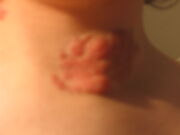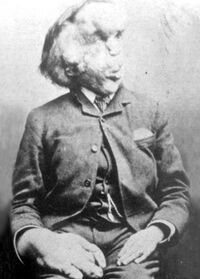| ||||||||||||||||
Neurofibromatosis is an autosomal dominant genetic disorder.
Types[]
There are two major forms and one newly discovered form:
- Neurofibromatosis type I (was known as Von Recklinghausen disease after Friedrich Daniel von Recklinghausen). Incidence is 1:3000.
- Neurofibromatosis type II (or "MISME Syndrome"). Incidence is 1:40,000.
Assessment |
Biopsychology |
Comparative |
Cognitive |
Developmental |
Language |
Individual differences |
Personality |
Philosophy |
Social |
Methods |
Statistics |
Clinical |
Educational |
Industrial |
Professional items |
World psychology |
Clinical: Approaches · Group therapy · Techniques · Types of problem · Areas of specialism · Taxonomies · Therapeutic issues · Modes of delivery · Model translation project · Personal experiences ·
- Schwannomatosis is a rare form that is clinically and genetically distinct from types I and II. Multiple schwannomas (rather than neurofibromas) occur, and about one-third of patients have these tumors in only one part of the body. The vestibular nerve is spared. Pain is the primary symptom, although numbness, tingling and weakness can also occur.
- Six other, extremely rare, forms are also recognized:
Symptoms[]
Neurofibromatosis type 1 - mutation on chromosome 17
- multiple neurofibromas on the skin and under the skin
- various other skin phenomena such as freckling of the groin and the arm pit
- a predisposition to particular tumors (both benign and malignant)
- the presence of 6 or more Café au lait spots (pigmented birthmarks) may suggest the presence of this condition
- skeletal abnormalities such as scoliosis or bowing of the legs might occur
- lisch nodules (iris nevi)- a hamartoma of iris
- tumor on the optic nerve
- a predisposition for dysthymia, mood disorders and certain learning disabilities
- a predisposition for tinnitus and an awareness of Visual snow or certain other "entoptic phenomenon"

plexiform neurofibroma
Neurofibromatosis type 2 - mutation on chromosome 22
- bilateral tumors, acoustic neuromas on the vestibulocochlear nerve
- the hallmark of NF 2 is hearing loss due to acoustic neuromas around the age of twenty
- the tumors may cause:
- headache
- balance problems, and Vertigo
- facial weakness/paralysis
- patients with NF2 may also develop other brain tumors, as well as spinal tumors
- Deafness and Tinnitus
Genetics and Hereditability[]
Neurofibromatosis type 1 is due to mutation on chromosome 17q , the gene product being Neurofibromin ( a GTPase activating enzyme).[1]
Neurofibromatosis type 2 is due to mutation on chromosome 22q , the gene product is Merlin, a cytoskeletal protein.
Both NF1 and NF2 are autosomal dominant disorders, meaning that only one copy of the mutated gene need be inherited to pass the disorder. A child of a parent with NF1 or NF2 and an unaffected parent will have a 50% chance of inheriting the disorder.
Complicating the question of heritability is the distiction between genotype and phenotype, that is, between the genetics and the actual manifestation of the disorder. In the case of NF1, no clear links between genotype and phenotype have been found, and the severity and specific nature of the symptoms may vary widely among family members with the disorder (Korf and Rubenstein 2005). In the case of NF2, however, manifestations are similar among family members; a strong genotype-phenotype correlation is believed to exist (ibid).
Both NF1 and NF2 can also appear spontaneously through random mutation, with no family history. These spontaneous or sporadic cases account for about one half of neurofibromatosis cases (ibid).
Family[]
Neurofibromatosis is considered a member of the neurocutaneous syndromes (phakomatoses). In addition to the types of neurofibromatosis, the phakomatoses also include tuberous sclerosis, Sturge-Weber syndrome and von Hippel-Lindau disease. This grouping is an artifact of an earlier time in medicine, before the distinct genetic basis of each of these diseases
History[]

Joseph Merrick
Joseph Merrick, the Elephant Man, was once considered to have been afflicted with either elephantiasis or neurofibromatosis type I. However, it is now generally believed that Merrick suffered from the very rare Proteus syndrome.
External links[]
- Information page from the National Institute of Neurological Disorders and Stroke (part of the National Institutes of Health in the United States) -- this Wikipedia article is based largely on this NINDS information page
- Home page of the Children's Tumor Foundation - Formerly: The National Neurofibromatosis Foundation (of the United States)
- Home page of the Texas Neurofibromatosis Foundation (of the United States)
- Home page of Neurofibromatosis, Inc. (of the United States)
- Home page of Neurofibromatosis, Inc. New England (of the United States)
- Home page of Neurofibromatosis, Inc. Mid-Atlantic (of the United States)
- Home page of NFMalaysia.org, a Malaysian effort to raise awareness for Neurofibromatosis.
- Home page of The Neurofibromatosis Association - UK based
- Neurofibromatosis - Epidemiology and Recent Advances
- The Let Them Hear Foundation A 501(c)(3) non-profit who provides free insurance appeal assistance to individuals who have been turned down by their insurers for cochlear implants or other hearing related surgery
- NEUROFIBROMATOSIS from the National Center for Biotechnology Information
- Home Page of NF2 Crew - A support group for people with NF2 and their families.
Notes[]
- ↑ Fauci,et al Harrison's Principle of Internal Medicine 16th Ed. p 2453
References[]
Korf, Bruce E. and Allan E. Rubenstein. 2005. Neurofibromatosis: A Handbook for Patients, Families, and Health Care Professionals.
de:Neurofibromatose es:Neurofibromatosis fr:Neurofibromatose nl:Neurofibromatose no:Nevrofibromatose